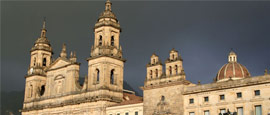Travel to Bogotá
Flying to Bogotá
Bogotá’s El Dorado International Airport is the main hub airport for Avianca (www.avianca.com), Copa Airlines Colombia (www.copaair.com), LATAM (www.latam.com), Satena (www.satena.com) and EasyFly (www.easyfly.com.co).
National airline and flag carrier of Colombia, Avianca is the only airline that offers direct flights from the UK to Bogotá. British Airways, Iberia, Lufthansa and Air France all offer non-direct routes. Avianca, Delta, United and American Airlines operate direct flights from the USA.
From London - 11 hours 25 minutes; New York - 5 hours 40 minutes; Los Angeles - 9 hours (including stopover); Toronto - 5 hours 45 minutes; Sydney - 24 hours (including stopover).
Website:www.eldorado.aero
Location:
The airport is located 15km (9 miles) northwest of central Bogotá.
Money:
ATMs and bureau de change desks are situated in various locations in all terminals.
Luggage:
Left-luggage is available in the main terminal on floor 1. Trolleys are US$2 for deposit, and the deposit is returned when the cart is returned. The lost and found office can be contacted on +57 1 439 7070, ext. 5112
Travel by road
Roads in Colombia are generally good, although driving in the Andean regions and parts of the rainforest requires a 4-wheel drive. Traffic drives on the right. The minimum driving age is 18. Speed limits are 45-60kph (28-37mph) in urban areas, 80kph (50mph) in rural areas and up to 120kph (75mph) on motorways. An International Driving Permit is required.
Kidnapping was a real risk when travelling by road in Colombia, but security is improving and travelling by bus is generally safe (especially on the main roads, such as the one linking Bogotá and Cartagena). Driving east of the Andes is not recommended, as incidences of kidnapping and carjacking still occur. It’s best to only drive during daylight hours.
Colombia doesn’t have a national breakdown service, so ensure this eventuality is covered by your insurance or by the car hire company.
Travelling to Bogotá from the south of the country, Route 24 from Popayan turns into Route 45 at Tesalia and then into Route 40 directly into Bogotá. Route 40 also sweeps in from the east. Those coming from Cartagena in the north should take Route 25 to Medellin, which uses Route 50 from Manizales to make its way to the capital.
From Cali - 8 hours 45 minutes; Medellín - 10 hours; Cartagena - 19 hours.
The main bus terminal in Bogotá (tel: +57 1 423 3630; www.terminaldetransporte.gov.co) is near Ciudad Salitre. It handles all arrivals and departures from Colombia to the rest of South America. It is divided into five zones, each represented by a different colour: yellow means that buses go to the south of the country, blue indicates bus lines to the east and west, red is for the north and South American destinations, green is for long-distance taxis and finally purple is for arrivals and local taxi services.
Travel by rail
Although trains still carry freight, inter-city passenger services are virtually non-existent. Plans are afoot to build the Bogotá's first metro line, the initial phase of which, from Portal Américas to Calle 6 in the city centre, is due to open in 2022.
Turistren (tel: +57 1 3 750 557; www.turistren.com.co) operate a small number of restored locomotives that chug from Bogotá to Zipaquirá and Cajicá at the weekends, but they are mainly for steam train sentimentalists who want to see the Salt Cathedral of Zipaquirá.
From Zipaquirá - 3 hours; Cajicá - 4 hours 35 minutes.
Do you have any Feedback about this page?
© 2025 Columbus Travel Media Ltd. All rights reserved. No part of this site may be reproduced without our written permission, click here for information on Columbus Content Solutions.








 You know where
You know where